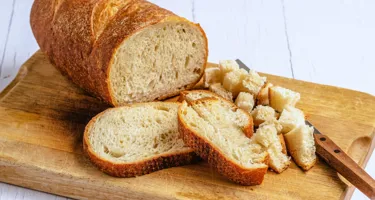
Bread is a staple in many kitchens, but most of us probably have doubts about how to store it best to keep it fresh for longer. In this article, we go through the different ways you can store bread, for example, in the fridge or at room temperature. We also look at other types of bread, such as focaccia, sourdough, and freshly baked bread, and how each of them is kept best.
Storing bread in the fridge
Storing bread in the fridge can sometimes keep it fresh for longer, but it depends on the type. Soft bread, such as sandwich loaves and rolls, is easily stored in the fridge. Since their texture is already soft, they will not lose any crispiness. Other soft bread or bread-based foods include English muffins, tortillas, bagels, and croissants. However, keep in mind that even softer types of bread might have their texture altered slightly depending on how the oils and fats react to cold temperatures.
Keeping soft leftover bread in the fridge can prolong its shelf life, but make sure to store it in proper packaging. Depending on your preferences, you can store it in airtight containers or plastic. Both have advantages and disadvantages. Airtight containers balance moisture and air circulation, meaning the bread stays fresh longer. The disadvantage is that they often take up more space in the fridge, and fitting different breads into the container might be difficult.
Plastic bags or wrapping lock in moisture, which helps keep the crust soft. However, if closed too tightly, too much moisture will create mould, so pay attention to the bread before eating it. Unlike an airtight container, wrapping leftover bread in cling film or placing it in a plastic bag requires no additional storage space in the fridge.
Storing bread at room temperature
Storing bread at room temperature benefits bread with crusty exteriors, such as baguette and ciabatta. Keeping those types at room temperature ensures that the bread remains crispy. Place it in a dry spot on the kitchen counter or in your pantry. This will prevent the bread from being exposed to excess heat and moisture. You can also keep it in a bread box, which is often used as part of the decoration in the kitchen.
Storing bread in the freezer
Storing bread in the freezer preserves it the longest, so this is the best option if you know that you will not use your leftovers within a few days or want to prepare for a bigger gathering. Wrap the bread thoroughly in cling film or foil to maintain the best texture after freezing. It is also a good idea to write the date on the wrapping so you keep track. You can store most of the bread in the freezer for about three months. When thawing the bread, you can leave it in the fridge overnight. You can also let it thaw at room temperature for a few hours if you do not have time to thaw it in the fridge. This will shorten the thawing time, but how long you need depends on the size of the bread. Finally, you can also thaw the frozen bread in the oven. Thaw it at low heat and keep an eye on it so it does not burn or get dry.
The best way to store bread depending on the type
As mentioned above, the best way to store bread depends on the type. While we all wish for a simple, fit-all solution, reality dictates that we consider the different kinds of bread. Below, we go through some of the most common types and how they are best stored. Despite being stored correctly, you might end up with stale bread. However, you can still put it to good use. In this article, we give you our best advice on what to do with stale bread .
How to store sourdough bread
Sourdough bread has surged in popularity in the past years, and with it has also come a surge in questions on how to store it properly. While the bread is known for its proactive bacteria that prevent mould longer than other types of bread, it still needs a proper storage method. The most popular method is also quite simple. Store freshly baked sourdough bread on a cooling rack with a tea towel over it. After it has cooled, wrap it in a tea towel or a bread bag to keep it fresh for 24 hours. As with most other types of bread, sourdough bread will also benefit from being stored in a bread box. Here, it will keep for a few days. Some types of sourdough bread can benefit from being stored in plastic bags. Because of their softer crust, sweet buns or bread rolls are not ruined by the humidity inside the plastic bags.
How to store freshly baked bread
The tender crumb and enticing aroma of freshly baked bread benefit from allowing it to cool completely on a wire rack before covering it. Keep it in a clean kitchen towel or a paper bag to allow air circulation. Avoid plastic bags or foil, as they trap the moisture inside, causing the bread to get soggy. While we encourage you to enjoy freshly baked bread within a day or two, as long as you keep it in a dry and cool place, the bread will last longer.
How to store focaccia bread
The best way to store focaccia bread is at room temperature. The Italian flatbread is a great pre-dinner snack that can be enjoyed all year, and that is also one of the many reasons to keep focaccia in your kitchen or pantry. All you need to do is wrap it in a kitchen towel or a cloth and place it in a bread box with good air circulation. While avoiding refrigerating your focaccia bread is important, there is an exception. For instance, if the focaccia bread has perishable ingredients on it, such as cheese or meat, we recommend storing it in the fridge. The downside is that the bread will lose some of its soft and chewy texture, but you may revive it by reheating it slightly in the oven before eating. If you need to store it longer, place it in a plastic bag in the freezer. Take it out the day before you need it, and reheat it in the oven before serving. When wrapped properly, you can keep focaccia in the freezer without any problems for three months.
How to store baguette
Baguette is an extremely popular type of bread, especially in southern Europe. To ensure you can enjoy your baguette in the best possible way, you need to know the best way to store it. We recommend keeping your baguette out of the fridge. The cool temperature can dry out the bread and turn it stale faster. Instead, wrap it tightly in plastic or aluminium foil, ensuring the bread is covered and sealed to keep the moisture inside. Store the wrapped baguette in a bread box or a paper bag to increase its longevity. If your bread turns stale, you can still put it to good use. In this article, we give you our best advice on what to do with stale bread .
Our most popular leftover bread recipes
If you have leftover bread, you can easily put it to use in different recipes. For example, make one of our popular toasts for lunch or create a savoury cauliflower gratin for dinner. You can find more inspiration in our overview of leftover bread recipes. We recommend a rye bread cake or a bread pudding with banana and chocolate if you want something sweet.







































